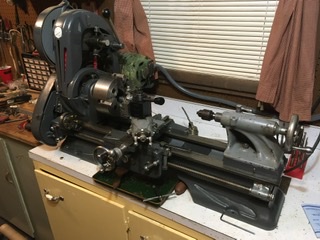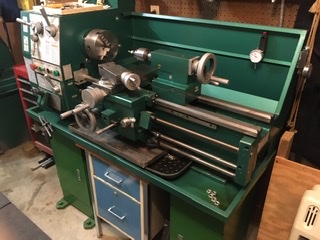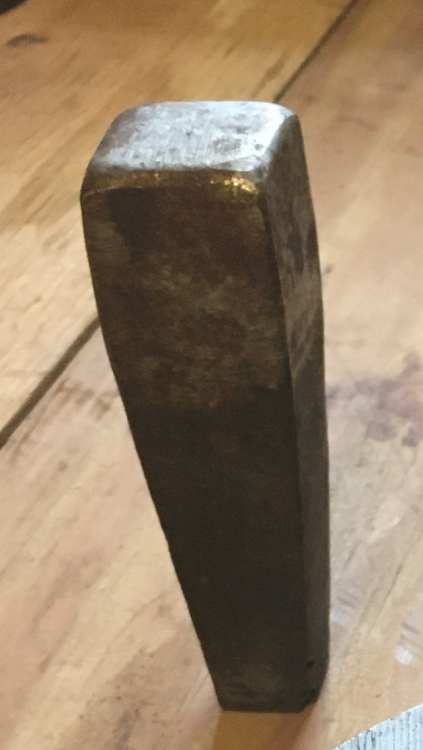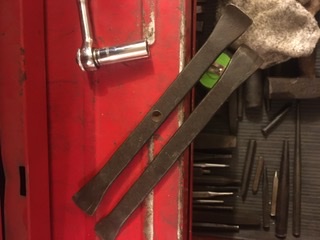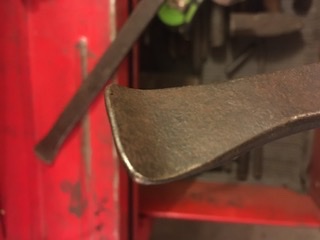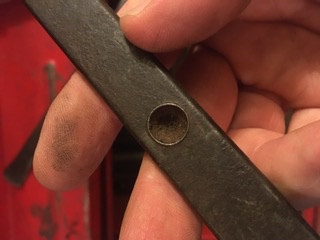
Balbasarado
Members-
Posts
39 -
Joined
-
Last visited
Content Type
Profiles
Forums
Articles
Gallery
Downloads
Events
Everything posted by Balbasarado
-
For some incomprehensible reason, I decided to mention that at 3:18 in a video titled "Forging a hardy tool bolster from extra heavy tubing" by John Switzer of Black Bear Forge for Youtube, I see him hold up a tool that is identical to the one this thread is for. He calls it a drift, and intends to use it to make a square hole. That's all. Don't know why I posted. Don't imagine it matters. I'm going back to watching the video now. I really enjoy his videos. Seems a very genuine fellow.
-
Well now that I've seen it, it makes sense. I found a video put out by a farrier supply called "Punching and pulling clips". Thanks for the thoughts guys.
-
Kanca vs Holland vs Hoffman
Balbasarado replied to stringstalker82's topic in Anvil Reviews by brand
Well no, not really anything like that. But with so many handy cosigners to follow you down whatever rambling path you take. Who would I be to argue? More like when I know exactly what I said, and my wife repeats it out loud as if I didn't just say it. More like that. But if that reminds you of hunting with one bullet in the olden days...I guess I give up. I've somehow found myself in blacksmith wonderland sitting down to dine with the mad hatter. I hope you and your one bullet don't shoot the white rabbit. I'm gonna go check the CO detector batteries. -
I'm not a farrier or even a blacksmith to be honest. But I've been gawking at anvils all over the web. I keep seeing farrier anvils with something called a clip horn. I did a youtube search and I got stuff for hair clips, and one video of a guy drawing a "clip" over the edge of the anvil. That guys anvil had what I think is a clip horn, but he didn't use it at all. So what's the deal with clip horns? Does anyone actually use them? What for? Does anyone have any video they could show, or book that explains? Even an illustration would suffice. Thanks very much for any information.
-
Kanca vs Holland vs Hoffman
Balbasarado replied to stringstalker82's topic in Anvil Reviews by brand
You kinda remind me of my wife with this post. I'm sure glad I have her, so I'll go ahead and appreciate your post too. I'll remain slack jawed and bewildered as well. Hey Stringstalker82! I'm looking forward to seeing your new anvil when you get it! I prefer the look of the thick waisted ones myself too. But I don't have enough experience to illuminate your decision in any meaningful way. I do know that much at least. Happy Hunting! Start a new thread for it too please. -
We used to have an old fellah to come verify a mare was pregnant. As I recall, he didn't use a glove when doing those manual checks. Just a bottle of something that looked like wire pulling lubricant, and a heavy stall door between himself and the mare. I sure was shocked the first time I saw it too.
-
Kanca vs Holland vs Hoffman
Balbasarado replied to stringstalker82's topic in Anvil Reviews by brand
This is the part that I thought would be something to think about. Copied from the 1914-1915 Hay Budden Catalog. Kanca did something that not even Hay Budden would have done. -
Kanca vs Holland vs Hoffman
Balbasarado replied to stringstalker82's topic in Anvil Reviews by brand
The BAM site has a Hay Budden catalog as a downloadable pdf. I had trouble editing it to make it smaller. If you do an internet search for Hay Budden Catalog, it should come up near the top of the results. -
Kanca vs Holland vs Hoffman
Balbasarado replied to stringstalker82's topic in Anvil Reviews by brand
Hay Budden had nearly the same disclaimer. Something to think about maybe. I'd be happy to have any of the three mentioned. In fact, I'm happy with my old ugly anvil too. Then again, all's I do is stare at the old girl, and make leaves out of modeling clay. -
Anvil resurfacing ??
Balbasarado replied to Mr. Pushups's topic in Repairing and Modification to Anvils
I have so little (none) experience that I would defer to others about suitability of one material or another. But Charles, is "malleable" the same as "ductile"? Both manufacturers mentioned call their anvils "ductile" iron. I've been reading about that, due to your statement and it seems like they are technically not the same thing. I admit that this is off topic, but I wonder if it's important to differentiate the two types, if they are indeed different, in the interest of information accuracy. -
Sure are a lot of nice looking old AND new anvils out there. Wow!
-
This is forever old, so not sure how useful it'll be. The first mill pictured in this thread is a Hardinge horizontal milling machine with a Rusnok bertical milling attachment. That Hardinge is not a benchtop mill by any measure. You're looking at 800 pounds of cast iron when counting the base. The second mill pictured is an Atlas horizontal milling machine, with a Rusnok vertical milling attachment. This mill can be called a bench top model and is highly sought after with guys who want their machine shop in the basement. The Hardinge could be used in industry and was built for it. The Atlas I'm not real sure about. Although I will say I would happily buy either one if given the opportunity. I've found Atlas mills for as low as $100 dollars and as much as $2400. The Hardinge machines are top of the line and rarely go for less than a grand around here. Rusnok was, so far as I know, a builder of attachments. They didn't build milling machines as far as I can recall. But if any of this has been enlightening, I highly recommend you research it yourself more thoroughly than accepting what my not so stellar memory provides as facts. Rusnok vertical milling attachments are high quality. But neither machine pictured is a Rusnok vertical milling machine. The pictured machines are two different horizontal milling machines, of widely disparate build quality, and valued for different reasons by different folk. One seemingly obvious difference being that the Atlas machine has die cast Zamak gears in it's power feed transmission, while everything in the Hardinge is cast iron. This fact steers many away from an Atlas machine, for fear that the gears will crumble under heavy use. My opinion is that if they've lasted this long, the Zamak is probably of no real concern. The most widely available benchtop vertical milling machines are probably those sold by Grizzly. A person would be money ahead buying one of those over a used machine for the same cost. The tooling is easy to find, and the machines are plug and play. But the machine asked about by the OP is a high quality machine that I think has the potential of lasting your lifetime. But, there's also a possibility that it may be hiding some serious and irreparable damage inside, that would cost more than two new ones to fix right...with no warranty to fall back on. Just for milling a little aluminum from time to time, I'd buy something new, and smaller. And that advice is worth every penny it cost ya.
-
The way I heard it, he had a new floor down before his wife got home from her weekend spa. He passed the new floor off as an anniversary gift and she was none the wiser.
-
I bought the little 10x18 Atlas as a pile of parts. Remarkably, almost all the parts had managed to stay together through at least 2 previous owners who thought they'd put it together someday and finally gave up on the idea. It had come from a high school that got rid of its useful curriculum, as so many have now done. I put it all back together over a year of free time. I put a Timken headstock on it, bought a good chuck, rebuilt the apron, rebuilt the fwd/reverse selector, installed new felt, repaired or replaced many broken pieces, and did some painting. I loathe painting, which is why it ended up three different colors. The motor is an original Atlas cast iron motor from a different project lathe that was simply too far gone to rebuild. The other machine is a 2013 Grizzly 12"x24" lathe. I bought it from a good old fellah named Leftie whose health had failed shortly after buying it new. He got it set up just in time to have some back trouble that laid him up for a year. He was headed to assisted living, so the adult children wanted it sold I think. Anyhow it's been a great machine, but moving 1000 pounds of lathe down cellar stairs isn't something I'll do again. Bringing it back up out of there was actually easier than letting it down. But still...
-
Yeah I figure if I can get accurate with a hammer on this little thing it will probably improve my skill with a full size anvil. Although I've already had some mis strikes on the regular anvil and it didn't seem to notice, accuracy is probably a fundamental skill to strive for.
-
It's amazing how those deals kinda fall in your lap sometimes. I got a Lincoln arc welder with 30 ft of leads for twenty dollars a couple weeks back. Heck of a thing...on wheels too.
-
I just always thought I was supposed to make something up. Geez do I feel foolish.
-
My wife told me she wants me to put up another shed for hot work. I guess that'll be on the agenda after this forge is complete. And after everything else on the honey do list. So maybe next year.
-
Anvil resurfacing ??
Balbasarado replied to Mr. Pushups's topic in Repairing and Modification to Anvils
You can buy a brand new TFS 100 pound double horn anvil Made in USA for 604$. Surely you wouldn't pass that up over a measly 4 bucks. There's one vendor that'd have it at your door step for an additional 30 bucks. I don't think I'm supposed to post links. But if I found it, I bet you can. I hope things get settled down for you and you're able to get back to anvil shopping asap. Oops. I didn't read you wanted something heavier than a hundred pounds. So i guess that's out. I would suggest that paying just a little more for what you really want is money well spent. JHM and TFS anvils seem pretty good for the money they're asking. -
My screen name translates to bearded man in Tagalog. Pretty straightforward I suppose.
-
So, scythe peening anvil eh? Which way was Albuquerque again? Ha!
-
Alright then. I don't foresee an influx of scythes in need of sharpening to my little "no hope for profit" shop, but it's good to be informed. Thanks!
-
That seems like a pretty good guess. I never heard of a tire spoon until now, but they look similar in image searches. Thanks!
-
Whatever this is, it's the only thing in my garage that has rebound comparable to my anvil. (70+%). I went on a little ball bearing bounce-a-thon earlier. The bottom is smaller than 3/4" and it's maybe 4" tall. Any idea?
-
A few years back, I bought a tray of punches and chisels at the estate auction of a blacksmith tool collector. So these were in there. Shoehorn/rivet setters?

